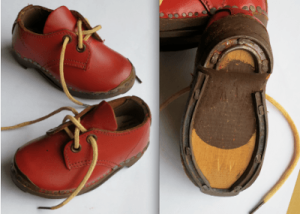And the clogs?
Well, my father had an expression – From Clogs to Clogs in Three Generations. It was a dire warning to remember that clogs , a mark of poverty and of hard work, were worn by people who, through hard work, industry and thrift, made a good future for their children. If we squander our inheritance, we will end up wearing clogs again. My grandmother wore clogs and so did her children until their grammar school days, much to their mortification. Aunt Edna was sent home from school for wearing clogs as they were too noisy and was told to return in leather shoes.

I have a tiny pair of traditional Lancashire clogs made by Walter Hurst of Hindley – his was the last family clog making business in the UK. He was a customer of the bank where my father was manager. Dad bought them for my son Michael when he was born. They are bright red and quite beautiful. Michael has never worn them. Notice the metal on the soles and heels of the clogs. They improved wear and kept the wooden part out of the wet and dirt on the mill floor. Mr Hurst’s business has now closed and he has retired. His family made clogs for the workers of the six cotton mills and 16 mines in the area for 103 years. His son, a pharmacist, did not follow into the clog making business. It was a dying trade and neither clog making nor shoe repair could maintain the family. We live in a disposable society where cheaply made goods are built, not or service but for fashion, and then quickly discarded.
Our embroidery is an exception to this and a link to that heritage of industry, craft and thrift. We are a tribute to both the clog makers and the clog wearers!
So I am off now to find my clogs and do some gardening.
Want to know more about Clog Dancing?
http://www.historic-uk.com/CultureUK/Clog-Dancing/
Back to Janet’s voice and my research.
Among the many things that interest me is the teaching of needlework in schools; it has died out completely. On the Antiques Roadshow is a sample folder or book, stitched by a young Irish girl in Kildare, of beautiful tiny garments pin-tucked, smocked, embroidered, hemmed and buttonholed to show off her skills to prospective employers. I could not find pictures though I did find a picture of the instruction manual used by the teacher as an example and guide. It is heartbreakingly beautiful.
When I saw the item being valued it gave me the shivers to think it was the work of a small child and it was the means of securing her life and her future.
It seems to me that many Victorian industrialists tried hard to provide for those unable to work or fend for themselves. They felt a social and moral obligation to do so. I am sure they lived comfortable lives themselves too, but they did provide employment, housing and education for their workforce. JP Coats certainly did so to the benefit of my ancestors. The company’s attitude to their workers and their education shows how enlightened they were.
Does this demonstrate that when one educates a girl, one can change life for future generations?
The other sampler I found was stitched by a woman, Lorina Bulwer, living in a lunatic ward in a workhouse around 1900. It was featured on the Antiques Road Show in the UK. Anyone who has read What She Left Behind by Ellen Marie Wiseman will know that one did not have to be a lunatic to be incarcerated in an asylum. It could be a matter of convenience for someone else. This is a video you really do need to see. It is a sampler like no other and is well worth connecting to the Antiques Road Show to see and hear about it. Please view this video even if you miss the others.
https://twitter.com/timetidemuseum/status/420852758531407873
How privileged we are to be able to sew for leisure and pleasure.
https://www.paisley.org.uk/paisley-history/ferguslie-half-timers-school/
Ferguslie Half Timers School was one of the finest school buildings in Scotland. Built in 1866 by the Coats family, they hired eminent architects to build a “palace of education”. It was described as “an admirably equipped school” and a “model of beauty and appropriateness”. It is now, unfortunately, derelict having suffered fires and then been left open to the weather. A drawing and floor plan of this school can be found from the link above. Half Timers were students who worked half a day in industry and went to school for the other half of the day. If you search the web you will find a video of the Ferguslie school in its current condition.
Eagley Mills owned by Chadwicks and then JP Coates has fared much better. It was closed in the 1970s and has been converted into residences. See the transformation of this old mill building.
http://www.pjlivesey-group.co.uk/case-study-4-eagley-mills/
In 1750 James and Patrick Clark began work in the loom equipment and silk thread business in Paisley, Scotland. In 1830, James and Peter Clark inherited the business naming it J. & P. Coats. The company expanded and is now an International provider of threads and other textile items and operates under a variety of names. One of the brands we all recognize is Clarks Anchor Embroidery Floss.
Social history tells us of the lives and times of our ancestors and the conditions in which they lived. I am hoping that these articles focussing on the daily lives of ordinary people will keep the details of their lives within our memories.
This is a good moment to offer profound thanks to Janet Sunderani without whom the last two blogs would not have happened. I have enjoyed this trip into our history about which I knew nothing. Researching for pictures and videos has been interesting and rewarding.
Leave a Reply